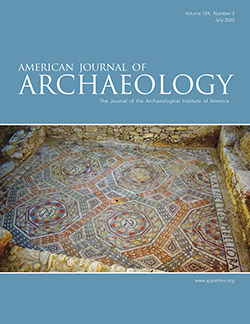AJA Open Access
BY-NCJuly 2020 (124.3)
Book Review
Exploring a Terra Incognita on Crete: Recent Research on Bronze Age Habitation in the Southern Ierapetra Isthmus
Edited by Konstantinos Chalikias and Emilia Oddo
Reviewed by L. Vance Watrous
This slim volume is a collection of eight papers originally given as a colloquium at the 2016 Annual Meeting of the Archaeological Institute of America in San Francisco. The geographical focus of these papers was on the large plain of Ierapetra and offshore island of Chryssi on the south coast of East Crete; the chronological emphasis is the Bronze Age. In the Classical to Roman periods, this was the territory of the powerful polis of Ierapytna. Today, the plain is carpeted with hundreds of plastic agricultural hothouses that have made Ierapetra the third wealthiest city in all of Greece. These hothouses have also prevented any systematic archaeological investigations of the area, as have been successfully carried out in other areas of Crete. The result is that these interesting papers are only able to give us a fragmentary picture of the region in the Bronze Age.
In the first paper, Krzysztof Nowicki traces three phases of local settlement development between the Final Neolithic (FN) and Early Minoan (EM) I periods (3700–2700 BCE). In phase 1 (FN I), the local population retreated to defensive locations, in the face of Late Neolithic (LN) II arrivals from the east. In phase 2 (LN II–EM I), two larger settlements controlled wide territories in the area. This pattern of settlement should indicate the presence of two EM I chiefdoms in the Isthmus of Ierapetra. In phase 3 (EM I Late), the landscape was extensively settled, indicating a period of security. In the second paper, Philip Betancourt describes a hilltop EM I site (Aphrodite’s Kephali) excavated by the Greek Archaeological Service, consisting of a two-room nonresidential building and a courtyard with a fire pit surrounded by a wall. Finds included at least nine storage pithoi (one held wine), Melian obsidian, and pottery from the north coast and the Mesara. Locals met and ate there, which implies some sort of regional organization. The site may have been a local fort or refuge center in case of hostilities.
In the third paper, Oddo distinguishes two separate pottery styles at Late Minoan (LM) I Myrtos-Pyrgos, one local (houses) and one Knossian (tomb). This difference may be due to different contexts, groups, or social classes. The next paper, by Vili Apostolakou et al., presents the EM–LM I pottery from a site at Bramiana in the foothills northwest of Ierapetra. This pottery was imported from the Mesara and the local north and south coasts. Next, Yiannis Papadatos and Chalikias discuss finds from their excavation of a Neopalatial megalithic building at Gaidourophas, high in the mountains northwest of Ierapetra. This elaborate two-story building produced a few pithoi, decorated vases, and cooking pots, as well as bronze axes, daggers, knives, a chisel, a spearhead, and a fragment of a copper ingot. A stone seal and bronze signet ring imply administrative activity. Lacking stone tools and industrial installations, the site is convincingly interpreted as a civic center and collecting point for the many small rural sites surrounding it.
Excavations by Thomas Brogan, Apostolakou, and Chrysa Sofianou at five LM IB houses on the offshore island of Chryssi near Ierapetra are described in the next paper. Dimitra Mylona reports on the numerous finds (e.g., mollusks, crushed seashells, fish bones) from these houses that point to intense exploitation of the sea for food and for the purple dye industry (i.e., Hexaplex trunculus shells). R. Angus Smith collects information on LM III tombs from several sites in the isthmus, the Ierapetra Plain, and Mochlos. In the concluding paper, Gerald Cadogan points to two lessons learned from this book: the area’s trade connections locally and with other areas of Crete were extensive, and our ignorance about the major Bronze Age precursor to the later Hellenistic–Roman city of Ierapetra continues.
L. Vance Watrous
Departments of Art History and Classics
University at Buffalo
watrous@buffalo.edu
